Northeast Vietnam is a great travel destination with a captivating blend of stunning landscapes and unique cultures. If your next destination is Southeast Asia, this is the hidden gem you need to discover.
Few regions in Vietnam can match the Northeast for its lush forests, rugged mountains, and abundant natural resources. In this part of the country, visitors can join in a variety of adventures, from trekking through mountainous terrain to immersing themselves in the rich culture of its diverse ethnic minority groups. While Northeast Vietnam may not be as widely recognized as other parts of Southeast Asia, it's gaining popularity among travelers seeking off-the-beaten-path adventures and cultural experiences.
- 1. Northeast Vietnam - General Information
- 2. Must-see attractions in Northeast Vietnam
- 2.1. Hoang Su Phi Rice Terraces
- 2.2. Rice Terraces in Tay Con Linh Mountain Foot
- 2.3. Dong Van Karst Plateau Geopark
- 2.4. Lung Cu Flag Tower
- 2.5. Hmong King Palace
- 2.6. Meo Vac Market
- 2.7. Ma Pi Leng Pass & Nho Que River
- 2.8. Non Nuoc Cao Bang Global Geopark
- 2.9. Ban Gioc Waterfall
- 2.10. Nguom Ngao Cave
- 2.11. Ba Be Lake & Ba Be National Park
- 2.12. Bac Son Valley
- 2.13. The Cultural Diversity of 32 Ethnic Groups
- 2.14. Long-standing Craft Villages in Northeast Vietnam
- 2.15. Halong Bay & Bai Tu Long Bay
- 3. Inspiring Northeast Vietnam Itineraries
- 3.1. Ha Giang Loop Itinerary (3 Days)
- 3.2. Hoang Su Phi Hiking Tour to Visit Rice Terraces & Ethnic Minorities (4 Days)
- 3.3. Itinerary to Northeast Vietnam's Highlights (5 Days)
- 3.4. Bac Son - Cao Bang - Ba Be Discovery ( 6 Days)
- 3.5. Itinerary to The Charming Beauty of the Northeast Vietnam (8 Days)
- 3.6. Bai Tu Long Bay and Northeast Vietnam Itinerary (9 Days)
- 4. Best time to visit Northeast Vietnam
1. Northeast Vietnam - General Information
Nestled in one of Vietnam's most strategic locations, the Northeast has been aptly named "the land at the head of the country". The region encompasses many provinces to the northeast of Hanoi. It shares borders with China to the north, faces a part of the East Sea to the east, and borders Northwest Vietnam.
The Northeast Vietnam comprises a total of six provinces, among them the Northeast mountainous region is renowned for its breathtaking landscapes, particularly in Tuyen Quang and Cao Bang. The most popular travel itinerary often includes these destinations, along with Hoang Su Phi, Dong Van, Meo Vac, Bao Lac, Ba Be, Bac Son, and Halong Bay.
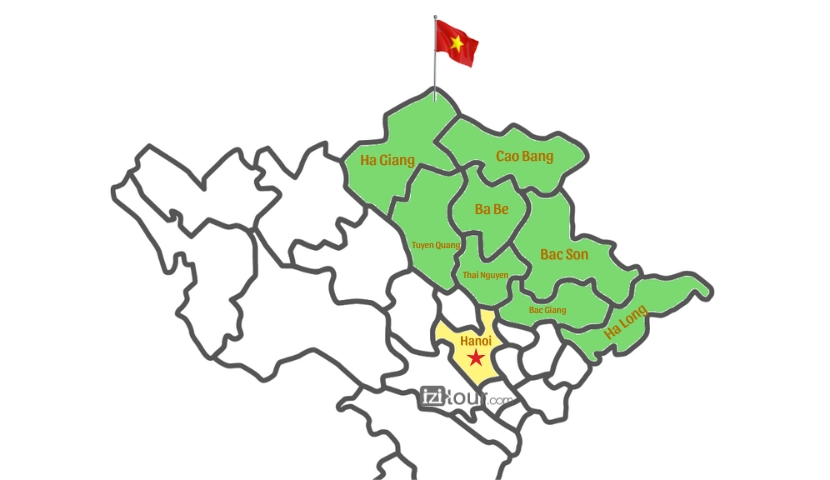
The Land of the Spectacular Landscapes
One of the most striking features of Northeast Vietnam is its natural beauty. The region is dotted with towering limestone karsts, creating dramatic landscapes that are sure to take your breath away. The terraced rice fields, a hallmark of the region, are a masterpiece of human ingenuity and offer a feast for the eyes, especially during the harvest season. The pristine lakes and rivers, such as Ba Be Lake, Ba Be National Park provide opportunities for boating, fishing, and biking.
The Mosaic of Diverse Ethnic Culture
Northeast Vietnam is home to a variety of ethnic groups, including the Hmong, Dao, Tay, Nung, and Lo Lo. Each group has its own unique language, customs, and traditions, which are reflected in their clothing, music, and cuisine. Visitors can learn about these cultures by visiting local villages, attending traditional festivals, and interacting with the friendly locals.
Adventure and Authentic Experiences
Especially, Northeast Vietnam is a paradise for adventure seekers. There are countless opportunities for trekking, hiking, biking, kayaking, and exploring caves. Numerous winding passes are both the new challenges but also the worthy journey. The region is also home to several national parks, offering a chance to experience the unique natural beauty.
2. Must-see attractions in Northeast Vietnam
2.1. Hoang Su Phi Rice Terraces
Hoang Su Phi is renowned for its breathtaking terraced rice fields, which blanket the hillsides in a vibrant yellow hue during the harvest season. From late September to early October, the ripening rice transforms from green to golden, creating a mesmerizing spectacle. Thousands of terraced fields cascade down the mountainsides, forming a intricate pattern that stretches across the district's approximately 3,000 hectares.
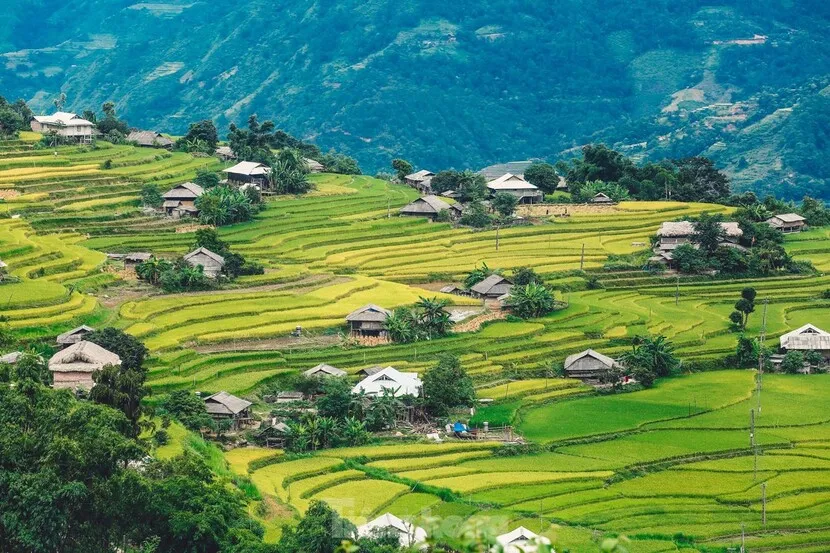
Beyond its natural beauty, Hoang Su Phi is home to 12 distinct ethnic minorities, including the Red Dao, Nung, and La Chi. These communities have been cultivating terraced rice fields for centuries, proving their ingenuity and resilience. While the exact origin of these fields remains uncertain, they undoubtedly played a crucial role in the local people's settlement.
The harmonious blend of terraced fields, mountains, and forests in Hoang Su Phi offers a serene and idyllic setting. For nature enthusiasts and authentic travelers, a visit to Hoang Su Phi can be a truly enriching experience. Activities such as trekking through the forests, exploring the fields, and interacting with the local villages can provide a deeper appreciation for this remarkable landscape.
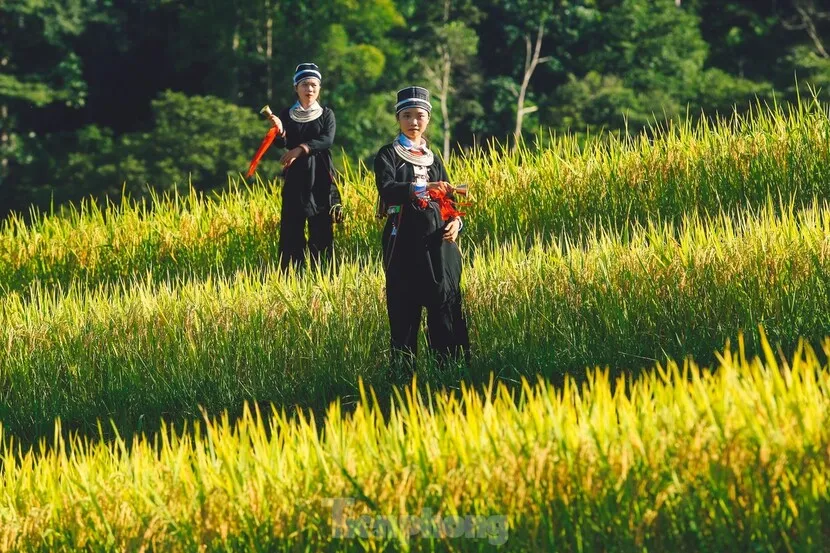
See more: The Charm of Hoang Su Phi's People and Terraced Field
2.2. Rice Terraces in Tay Con Linh Mountain Foot
Tay Con Linh - "Roof of Northeast Vietnam" - is a captivating trekking destination that attracts nature enthusiasts. With its impressive height and majestic scenery, Tay Con Linh is not only a challenging adventure for those seeking to conquer mountain peaks but also a serene escape to explore the pristine beauty of nature.
The journey to explore the terraced fields and villages at the foot of Tay Con Linh Mountain even offers visitors more interesting experiences than reaching the top of the mountain, from the beautiful villages and ancient moss-covered houses to stunning rice fields. Visitors can visit Khuoi My and Lung Vai Villages, located not far from Ha Giang City. These places will allure you with their magnificent mountain views and rustic thatched houses. The climate here is cool and fresh all year round. Behind the villages is the Tay Con Linh mountain range, adding to the magnificent picture. In particular, many terraced fields are carved into the hillside, which are as beautiful as in Mu Cang Chai and Hoang Su Phi.

Like many other beautiful villages in Ha Giang, Khuoi My, and Lung Vai, in addition to the scenery, these places also offer visitors the opportunity to learn more about the lives of ethnic minorities. Inhabited primarily by the Dao and Tay ethnic groups, Khuoi My and Lung Vai feature traditional stilt houses with thatched roofs. Over time, the moss-covered palm roofs exude an ancient beauty. As you wander through the village, you will see stilt houses standing out among the deep green rice fields. Although these villages also have many modern houses with corrugated iron roofs today, the rustic simplicity of the ethnic minorities still dominates, creating a unique impression.
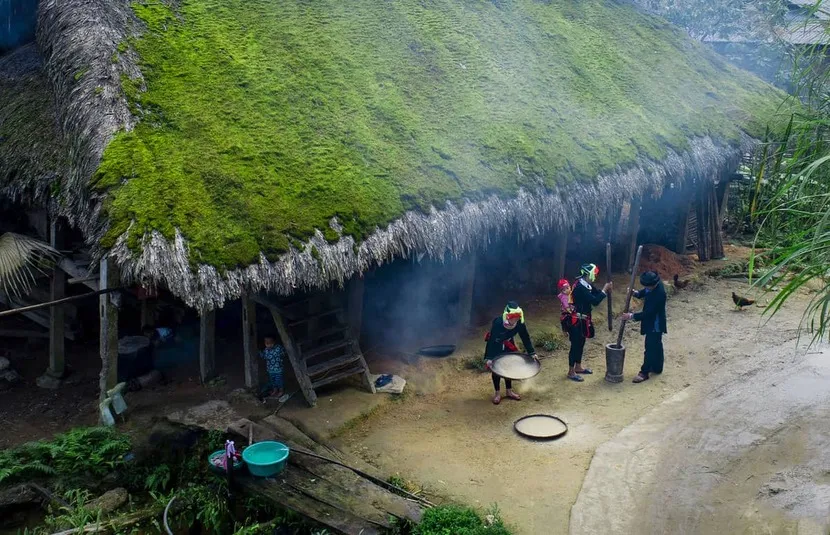
Moss-covered roof houses on the road to conquer Tay Con Linh
The best time to travel to the foothills of Tay Con Linh is during the rice ripening season in November. This is the time when the rice begins to change from fresh green to shimmering yellow. The moment the sun rises from the east, shining golden rays on the rice fields is breathtakingly beautiful.
Tay Con Linh is suitable for exploring by trekking in one day. However, staying overnight at a local homestay allows for a more immersive experience, providing an opportunity to connect with the community. In Tha Village and Ha Thanh Village, locals are developing sustainable tourism so visitors staying at homestays will experience life with the local people.
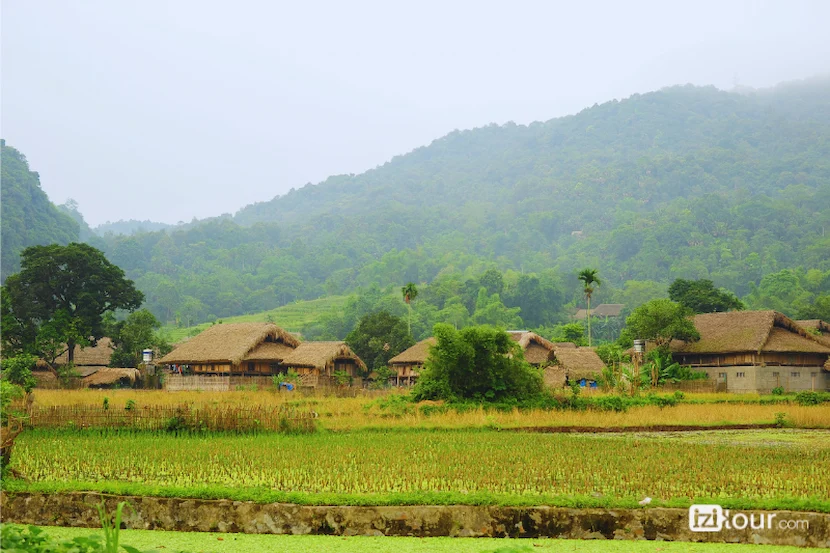
See more: Tay Con Linh Mountain - the Roof of the Northeast Vietnam
2.3. Dong Van Karst Plateau Geopark
Ha Giang, located at Vietnam's northernmost tip, is divided into three distinct natural regions: the low mountains in the south, the mountainous areas in the west, and the highlands in the north. The northern highland is widely known as the Dong Van Karst Plateau UNESCO Global Geopark, a geological marvel formed over 500 million years ago.
The Dong Van Karst Plateau is a majestic mountain range with rugged terrain, an average altitude of 1,000 meters, and numerous peaks exceeding 1,500 meters. It spans four districts: Quan Ba, Yen Minh, Dong Van, and Meo Vac.

Quan Ba Twin Mountains - isosceles triangle limestone mountains
Comprising mostly limestone mountains and karst terrain, the Dong Van Karst Plateau boasts a unique landscape featuring sharp ridges, deep ravines, towering cliffs, pyramid-like peaks, valleys, caves, and rock gardens. Erosion has carved out canyons such as Tu San (700-800 meters deep). The plateau's primeval forests, including Du Gia Nature Reserve, are home to a diverse array of flora and fauna, such as conifers, mountain goats, langur, and numerous indigenous bird species. Especially the plateau's surface is still undergoing slow weathering, resulting in an evolving and dramatic landscape.
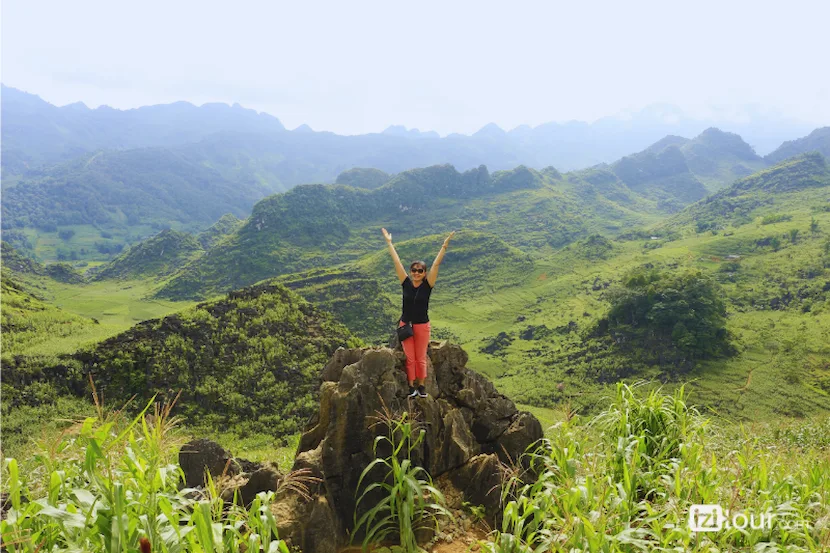
Van Chai Stone Book - A magnificent sight with hundreds of limestone cones scattered across the terrain
Due to the limestone terrain, arable land is limited. To cultivate crops like corn, local communities have ingeniously stacked rocks, carried soil, and filled crevices to create small fertile patches. This innovative farming technique has enabled them to sustain agriculture in the challenging mountainous environment.
Besides the natural scenery, Dong Van is home to 17 ethnic groups. Each ethnic group has its distinctive lifestyle and traditions, contributing to the region's rich cultural heritage.
To explore the Dong Van Karst Plateau and other attractions in Ha Giang, follow the Ha Giang Loop route.
2.4. Lung Cu Flag Tower
Perched at the northernmost tip of Vietnam, Lung Cu Flag Tower stands as a symbol of national pride and sovereignty. Located over 320 kilometers from Hanoi, it’s very near the border between Vietnam and China. Atop Dragon Mountain, the flag tower is a revered landmark, marking the northernmost point of the country. The giant red and yellow flag covers 54 square meters, representing the harmonious unity of Vietnam's 54 ethnic groups residing within the borders.
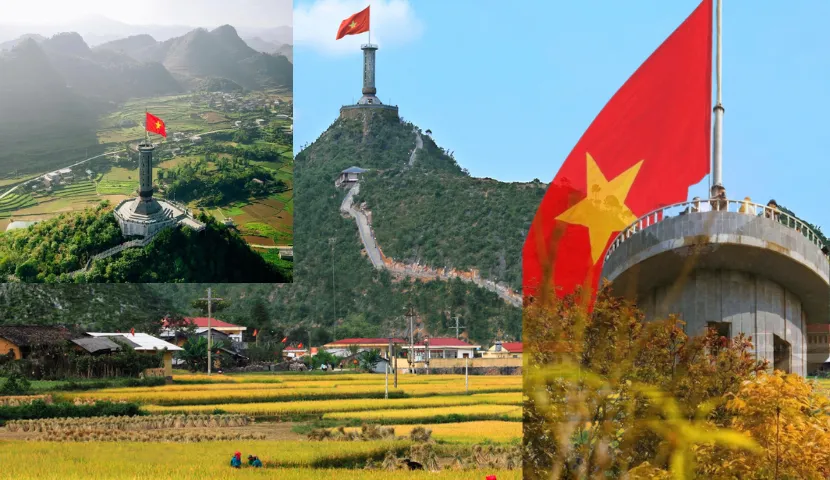
To reach the summit where the national flag proudly flies, visitors must climb 839 steps. However, it worth your try. From the summit, visitors can admire the breathtaking vistas of the surrounding landscape, including verdant rice fields, lush green mountain and traditional stilt houses of the local ethnic groups like Lo Lo and Hmong. At the base of the flagpole, a memorial house showcases the tools, attire, and cultural artifacts of Hà Giang's diverse ethnic groups.
2.5. Hmong King Palace
The Hmong King's Palace is a remarkable architectural construction built in the 19th century in Ha Giang. The life and career of its owner, Mr. Vuong Chinh Duc, have left an indelible mark on the history of Dong Van. Renowned for his intelligence, business acumen, and being excellent in khen (a Hmong instrument), Vuong Chinh Duc was crowned the leader of the Hmong people in Sa Phin and Pho Bang at the young age of 30. As the paramount chief of the Hmong during the mountainous region's feudal period, he became known as the "Hmong King". At the height of his power and wealth, he commissioned the construction of this magnificent palace.

The palace boasts a unique architectural style that seamlessly blends ancient Chinese and Hmong elements. Expert craftsmen skillfully combined materials from Yunnan with local resources such as blue stone, precious woods, and terracotta tiles, creating a harmonious and aesthetically pleasing structure. Despite enduring numerous wars, the palace remains quite well-preserved. Visitors are often surprised by the profound understanding of feng shui as they stand here and know the palace's location and the surrounding landscape well.
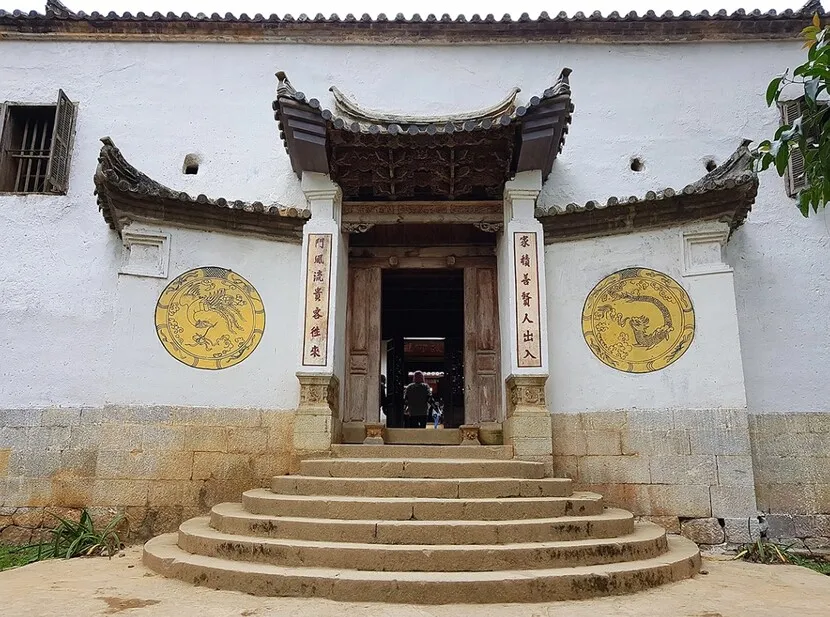
Today, the Hmong King's Palace is an unmissable stop on the Ha Giang Loop and also a cultural highlight for travelers exploring Northeast Vietnam.
See more: The unique architecture of the Hmong King's palace
2.6. Meo Vac Market
If you visit the region on Sunday, don't miss visiting Meo Vac market. This market is the largest and most culturally rich in Ha Giang. Held every Sunday from around 4 a.m. to 4 p.m. in the heart of Meo Vac town, the market draws people from nearby villages and towns. From early morning, locals of all ages, dressed in their traditional attire, flock to the market to buy and sell goods.

The market offers a wide range of locally produced goods, including fresh produce, farm tools, handwoven textiles, spices, and herbal remedies. Livestock, particularly cattle, is also traded here, supplying the region's demand for meat. With the changing times, electronic goods have started appearing in the market to cater to the needs of the locals.
Beyond the bustling daily activities, the market becomes even more vibrant during the periods before and after Tet (Lunar New Year). Before Tet, people come to purchase supplies for the festive season, while the post-Tet period is marked by traditional games and celebrations. Besides a shopping place, Meo Vac Market is also a place for locals to meet potential romantic partners.

2.7. Ma Pi Leng Pass & Nho Que River
Nho Que River and Ma Pi Leng Pass are two of the most iconic attractions in Northeast Vietnam. Together, they form a breathtaking landscape that has captivated visitors for generations.
Ma Pi Leng Pass has long been hailed as the King of Vietnam’s mountain passes". Its towering limestone cliffs form a dramatic canyon alongside the serene, emerald-green Nho Que River.

Perched at an altitude of 1,500 meters above sea level in the Dong Van Karst Plateau, Ma Pi Leng Pass is the most stunning mountain road in all Vietnam. It is a popular destination for motorcyclists and car drivers, who enjoy the challenge of navigating the winding road. Travelers can marvel at the soaring cliffs on one side and the deep abyss on the other while you admire the meandering Nho Que River. From the top of the pass, visitors can enjoy panoramic views of the valley, mountains, and river, creating a truly awe-inspiring landscape. A leisurely boat trip on the Nho Que River, which winds its way beneath the cliffs, provides a serene and unforgettable experience.
The combination of breathtaking views, adventure, and cultural immersion makes this region a must-visit destination for anyone traveling to Northeast Vietnam.
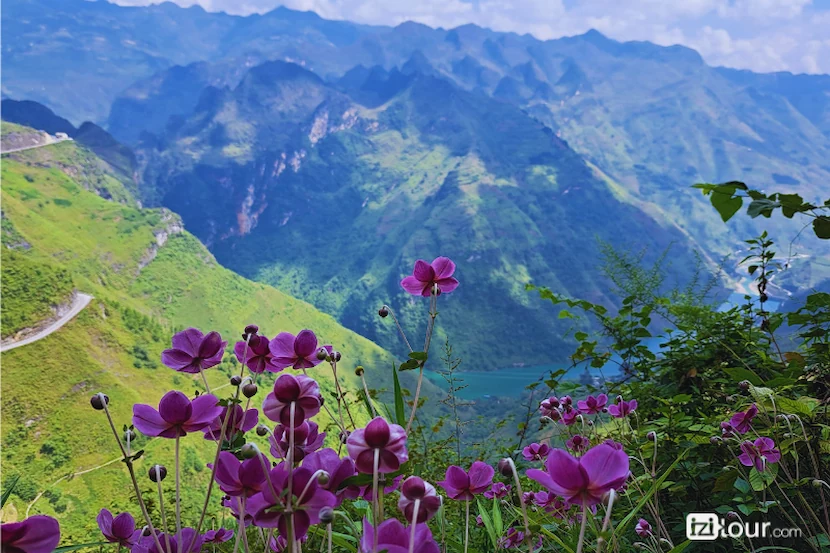
2.8. Non Nuoc Cao Bang Global Geopark
Non Nuoc Cao Bang Geopark, recognized as a UNESCO Global Geopark in 2018, is a geological marvel in Northeast Vietnam. It became the second global geopark in Vietnam after Dong Van Karst Plateau Geopark. Spanning half of Cao Bang province, this geopark showcases an array of fossils, marine sediments, volcanic rocks, minerals, and remarkable limestone formations that provide evidence of Earth's evolution over 500 million years.
Visitors to Non Nuoc Cao Bang Geopark will be captivated by the diverse limestone landscapes, including towering stone towers, valleys, caves, river and lake systems, and underground caverns. The region is renowned for its abundance of caves, with over 200 natural caves, many of which feature stunning stalactites like Nguom Ngao Cave. The cave on God's Eye Mountain is another attraction, surrounded by majestic mountains and winding rivers, offers breathtaking panoramic views from above. Beyond its geological wonders, Non Nuoc Cao Bang boasts the majestic Ban Gioc Waterfall.
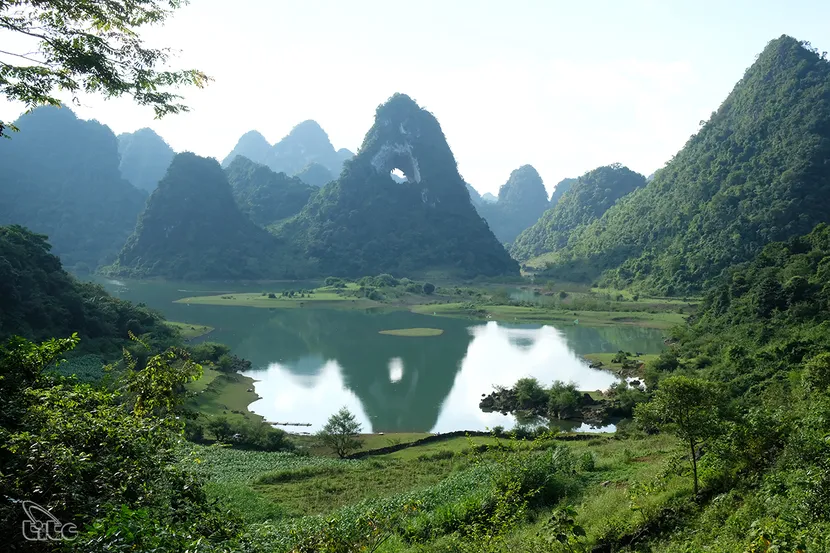
The God's Eye Mountain is located in the middle of Cao Bang Geopark.
The geopark has preserved its pristine beauty so well, making it a go-to destination for any traveller seeking a blend of natural beauty and cultural experiences. The rustic, peaceful atmosphere, combined with the peaceful landscapes, invites visitors to slow down and savor the moments.
2.9. Ban Gioc Waterfall
Ban Gioc Waterfall, located on the Vietnam-China border, is renowned as the most beautiful waterfalls in Vietnam. It's also Southeast Asia's largest natural waterfall and the fourth largest in the world situated along an international border. As such, Ban Gioc Waterfall is an absolute must-visit on any trip to North East Vietnam.
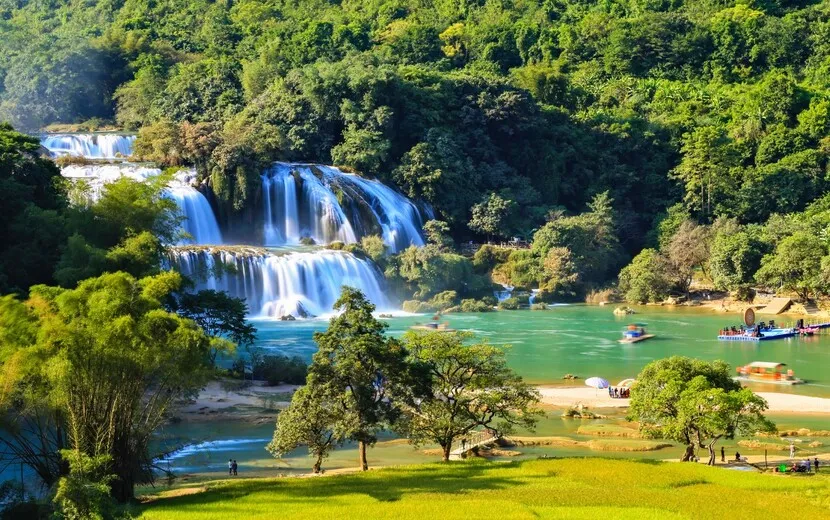
Towering at over 60 meters with a longest drop of 30 meters, the waterfall cascades over multiple tiers of limestone, spanning hundreds of meters. A small island covered in lush vegetation divides the waterfall into three distinct branches. During autumn, the river takes on a stunning jade-green hue. The mist often rises from the waterfall, creating a magical atmosphere when illuminated by the sunlight. From above, the sight of the cascading water and foamy spray is truly breathtaking.
For the best experience, the optimal time to visit Ban Gioc Waterfall is between 11:30 AM and 2:00 PM. Taking a bamboo boat ride close to the cool, refreshing water is a perfect way to escape the summer heat.
2.10. Nguom Ngao Cave
Another unmissable attraction in Northeast Vietnam is Nguom Ngao Cave. As one of the country’s most recently discovered caves, Nguom Ngao retains its pristine natural beauty.
Scientific research suggests that this limestone cave formed approximately 400 million years ago. Classified as one of Vietnam’s most beautiful caves, Nguom Ngao offers a cool retreat during the summer months and a warm sanctuary in winter.
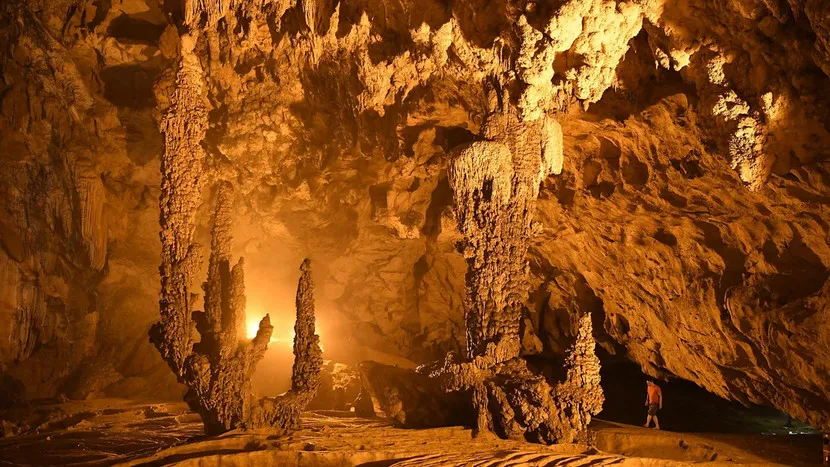
The cave is adorned with countless stalagmites reaching up from the ground and stalactites hanging from the ceiling, creating a magical and enchanting atmosphere. The unique mineral composition of the limestone gives the formations a distinct color, unlike those found in any other caves. Your imagination will run wild as you spot formations resembling human figures, trees, animals, fairies, lotus flowers, and even a mother's breast. The most prominent rock formation are the inverted lotus-shaped stalactites and the solitary stone pillars.. As you venture deeper into the cave, the beauty becomes even more captivating. In some areas, the passage is narrow enough for only one person to pass through, while in others, stalactites block the way, forcing you to duck your head. Sometimes, you'll encounter small streams and the soothing sound of dripping water.
Created entirely by nature, the cave's beauty is truly captivating. Two tour routes are available, offering visitors a choice between a 2km and a 3km journey.
2.11. Ba Be Lake & Ba Be National Park
Nature has crafted Ba Be Lake, the largest natural freshwater lake in Vietnam. From the mountain peaks, the lake appears as a hidden gem nestled amidst the stunning karst landscapes of northeastern Vietnam. The small island in the lake look like the serene oasis nestled amidst the limestone karsts of Ba Be National Park. On sunny days, the lake's still waters mirror the surrounding mountains and sky, creating a picturesque landscape. A boat trip on its tranquil waters is a truly unforgettable experience for any visitor.
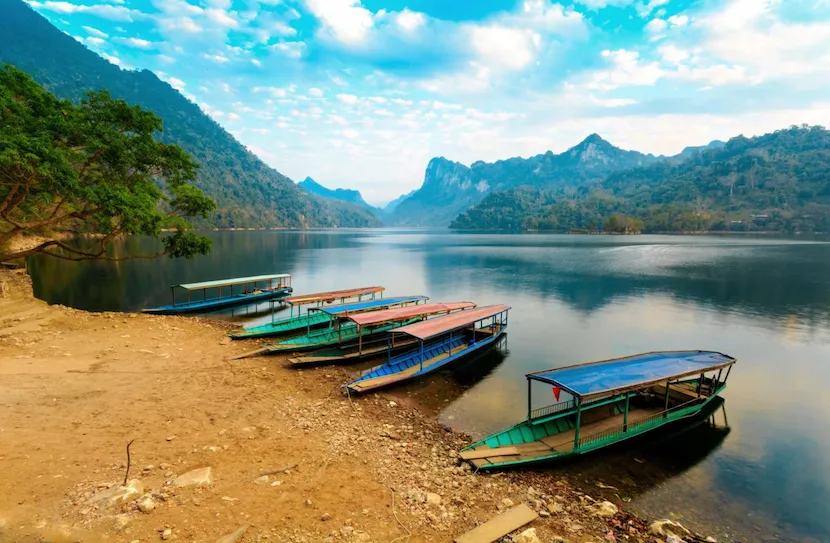
Ba Be Lake is home to numerous freshwater fish species native to northeast Vietnam
The Nang River flows into Ba Be Lake and has also carved out Puong Cave, a 300-meter-long cavern decorated with captivating stalactites and stalagmites. The river winds its way through the cave, creating a magical atmosphere as it flows beneath these extraordinary formations. Nearby, Hua Ma Cave offers another opportunity to explore the wonders of the nature. Both caves provide a cool and refreshing respite from the outside world. Dau Dang Waterfall, with its impressive height of over 1,000 meters, cascades down in three tiers, adding a touch of wild beauty to the landscape.
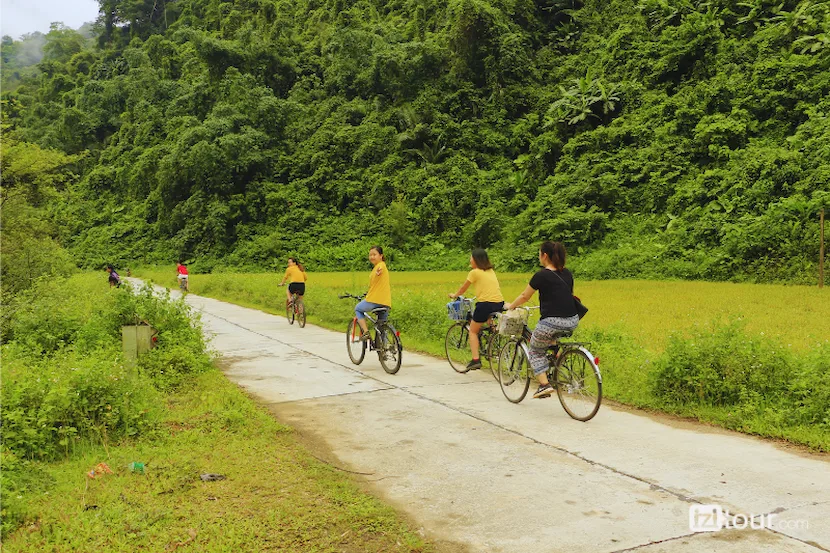
Visitors to Ba Be National Park can not only immerse themselves in the stunning natural beauty but also experience the rich cultural heritage of the Tay, Dao, and Hmong ethnic minorities. The local people are renowned for their hospitality. You might be invited into their homes to share in their daily lives, offering traditional corn wine and the opportunity to stay overnight in a stilt house.
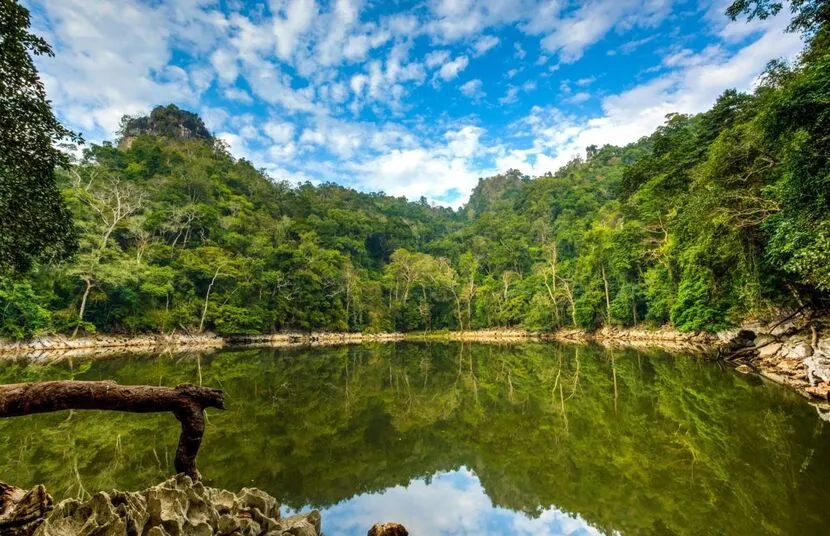
Geological studies have revealed that the limestone formations are approximately 450 million years old.
2.12. Bac Son Valley
Bac Son Valley, nestled amidst towering limestone peaks, has emerged as a popular community-based tourism destination, yet it remains relatively undiscovered by many international travelers.
Shaped like a vast bowl, the valley provides ideal conditions for rice cultivation. July and November mark the Bac Son’s rice harvest season, transforming the landscape into a breathtaking patchwork of golden fields. Winding rivers and streams meander through the valley, creating a picturesque scene.

For panoramic views, climb the more than one thousand steps to the summit of Na Lay Mountain. From here, you can admire the paddy fields spread out like giant, colorful quilts. The autumn harvest season offers particularly stunning vistas, with the valley ablaze in golden glow.
Bac Son Valley has been home to the Tay and Nung ethnic minorities for centuries. Their traditional stilt houses dot the landscape. These houses, with their distinctive architecture and south-facing orientation, have been passed down through generations. Surrounded by limestone mountains, the valley has preserved its rich cultural heritage.

The paddy field turning golden in Bac Son Valley
2.13. The Cultural Diversity of 32 Ethnic Groups
The cultural diversity of Northeast Vietnam is one of its most precious assets in addition to the natural beauty. The Dong Van Karst Plateau alone is home to over 17 ethnic minority groups, including the Hmong, Tay, Nung, Dao, Thai, San Chi, Bo Y, Pu Peo and Lo Lo,... Cao Bang is also home to several ethnic groups. Each group has its unique customs, traditions, and festivals, contributing to the region's rich cultural heritage. Let's discover some of ethnic minorities you may encounter during your journey.
The Hmong ethnic group: Known for their colorful textiles and distinctive silver jewelry, the Hmong people have a deep connection to nature. Their traditional festivals, such as the Gau Tao and Khen Mong, celebrate their agricultural traditions and spiritual beliefs. The Gau Tao festival is a significant event in the Hmong calendar. Held at the beginning of the lunar year, it is a time for the community to come together to pray for good health and bountiful harvests.
Hmong women are particularly skilled weavers, creating durable fabrics from flax that are both practical and beautiful. The Hmong are also adept at various crafts, including metalwork, woodwork, and basketry. Their cuisine is hearty and flavorful, featuring dishes made with corn, horse meat, and pork, prepared using traditional methods.

The Tay ethnic group: The Tay people are famous for their indigo-dyed clothing and traditional stilt houses. Their indigo dyeing techniques and woodworking skills have been passed down through generations. The annual Long Tong festival celebrated at the beginning of the year, and the Moon-Praying festival in August are important cultural events that showcase their unique customs and beliefs. Tha village and Ha Thanh village, Ha Giang are inhabited by Tay people, where their culture is still imbued in the daily life.
The Nung ethnic group: The Nung people have a strong connection to their land and ancestors. Their stilt houses have a ground floor area for livestock and tools, and the kitchen not only serves for cooking but also provides warmth. Nung women weave their own clothing. From sticky and regular rice, they've created a variety of dishes, such as purple rice cakes and mugwort cakes. On special occasions, a whole roasted pig stuffed with "mac mat" leaves is a must-have. The Nung people follow a polytheistic belief system and worship their ancestors. Among their many crafts, including weaving, blacksmithing, casting, basketry, woodworking, and making dó paper and yin-yang tiles, blacksmithing has been particularly well-preserved and continues to flourish.
The San Chi ethnic group: The San Chi people traditionally choose to build their villages in mountainous regions. For many years, these villages have offered a peaceful and harmonious way of life, centered around their distinctive stilt houses. San Chi women, in particular, take great pride in their traditional attire, which they wear daily, regardless of outdoor activities. In Cao Bang province, the San Chi has a unique coming-of-age ceremony known as the "Cap Sac," which marks the transition from boyhood to manhood and provides the young man with a spiritual name for the afterlife.
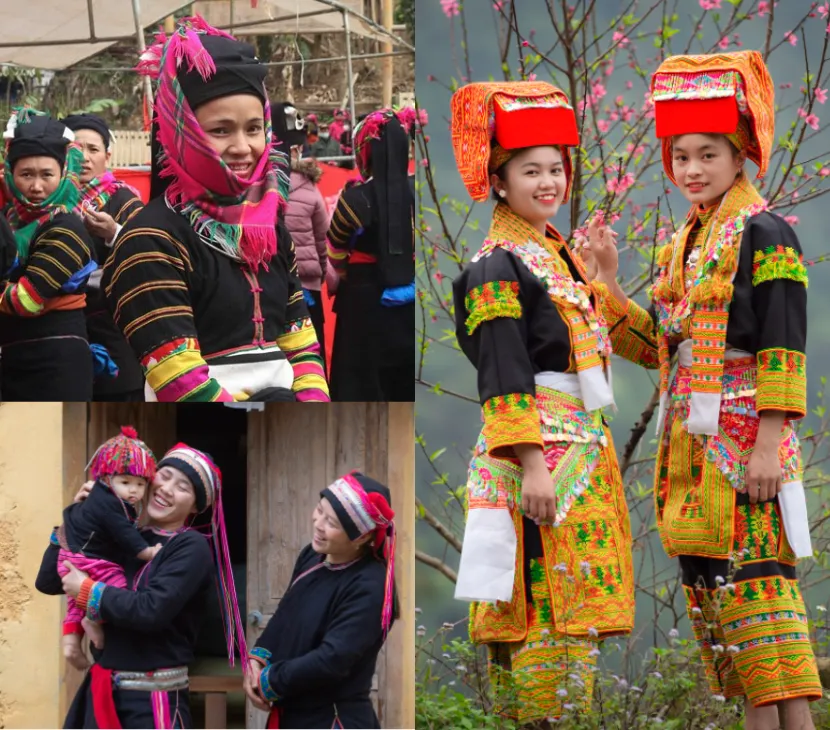
Traditional costumes of the Lo Lo and Dao ethnic groups
The Lo Lo ethnic group: The Lo Lo people, including Black Lo Lo and Flower Lo Lo, are always attractive in their traditional attire is truly striking, with intricate embroidery and a vibrant color palette that showcases the women's exceptional craftsmanship. This ethnic group held many festivals throughout the year, like the Rain-praying Festival and the Corn Harvest Festival. The Lo Lo people are also skilled musicians, often playing the monochord lute (đàn bầu) and traditional drums. These instruments accompany their captivating traditional dances, which are typically performed in religious ceremonies. One unique aspect of Lo Lo cuisine is the use of banana tree as an ingredient. They finely slice the banana stem, mash it, and then use it in various dishes.

The typical rammed earth house of the Lo Lo people has been preserved for many generations
The Dao ethnic group: The Dao people of Vietnam have a profound understanding of their natural environment, reflected in their traditional architectures and ritual practices like Rain-praying Ceremony, Harvest-praying Ceremony,... They also organize Cap Sac ceremony like the San Chi people. Their colorful textiles, intricate embroidery showcase their artistic talents and connection to the homeland. The Dao people are known for their community-oriented lifestyle and their strong adherence to ancient traditions. Visitors can experience their rich culture by attending local markets or visiting mountainous villages where they have long resided.
Each ethnic group has its unique customs, traditions, and ways of life, making this region a fascinating destination for travelers and cultural enthusiasts alike.
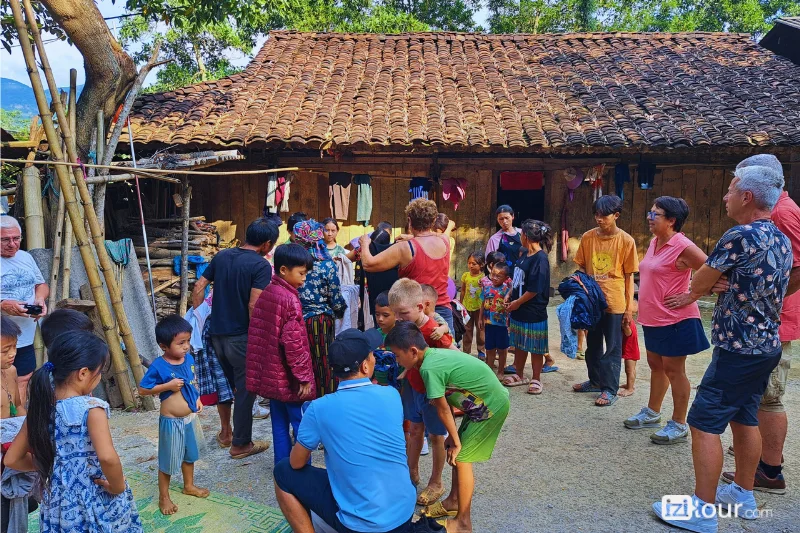
Meet and greet the locals
2.14. Long-standing Craft Villages in Northeast Vietnam
Northeast Vietnam’s rich cultural diversity has fostered vibrant tradition of many crafts. Thanks to the skills and knowledge passed down through generations, many villages continue to produce unique, handcrafted goods. From the delicate linen weaving of the Hmong people to the intricate metalwork of the Nung, these traditional crafts offer a unique cultural aspect.
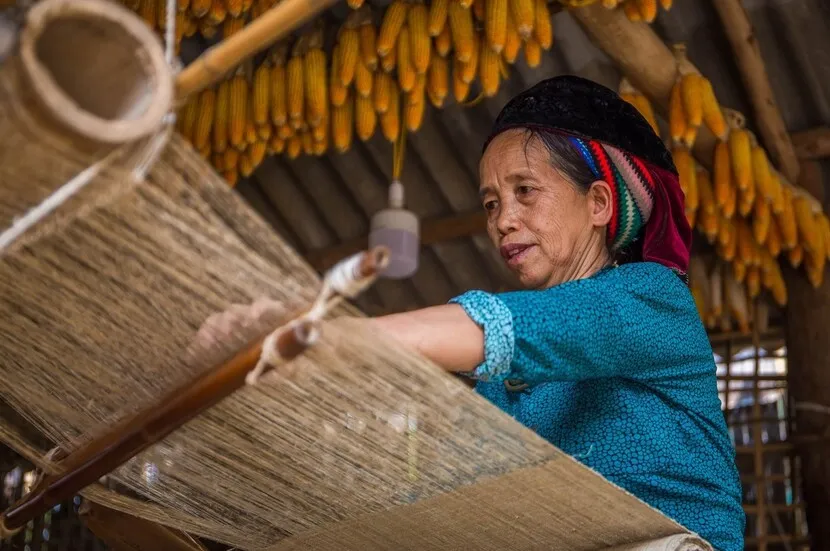
Lung Tam Linen Village: Linen weaving holds a special place in the life of the Hmong people. In the village of Lùng Tám, women have been spinning and weaving linen for centuries. According to traditional beliefs, spinning and weaving is one of the jobs that any Hmong woman must master when she reaches adulthood. This traditional craft is not only a source of livelihood but also a way to express their cultural identity. Every piece of linen tells a story, reflecting the Hmong people's connection to their heritage and nature.
Phuc Sen Blacksmith Village: The village boasts a blacksmithing tradition spanning over 300 years. Initially, the village focused on forging agricultural tools and household items. The Nung An people have their own time-honored techniques for creating razor-sharp knives. Today, the village offers a diverse range of products.
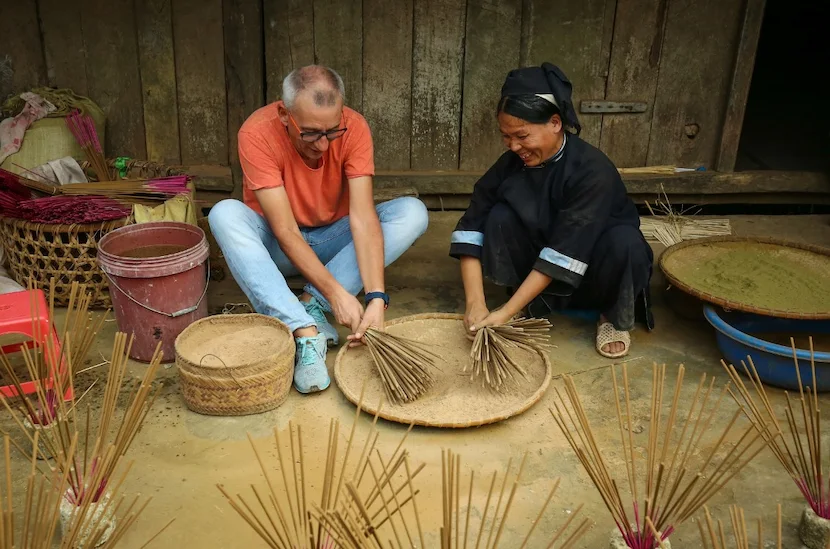
Phia Thap Incense Village: In recent years, Phia Thap Village has embraced community tourism, welcoming visitors from far and wide to experience rural life firsthand. One of the most popular activities for tourists is participating in the traditional incense-making process.
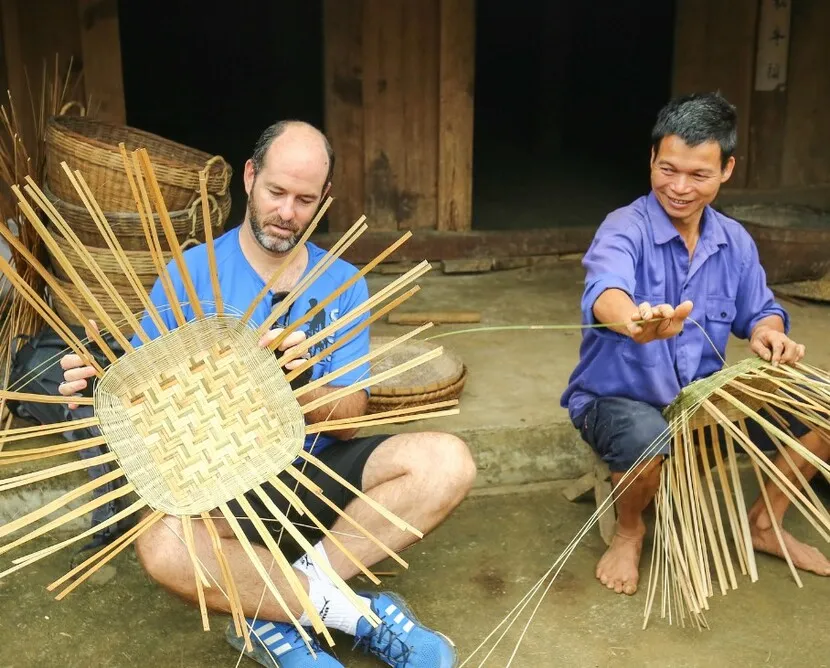
Bong Son Bamboo Weaving Village: Bong Son is renowned for its high-quality bamboo products. The village's artisans create a variety of items, including bamboo mats for beds and drying grains, as well as storage bins and baskets. Bamboo weaving is a traditional craft passed down through generations in Bong Son, often practiced during off-peak hours or as a side job. Creating durable and beautiful bamboo products requires exceptional skill and craftsmanship.
2.15. Halong Bay & Bai Tu Long Bay
The thousands of limestone islands, rising dramatically from emerald waters, create a truly breathtaking landscape. It's beautiful Halong Bay in the Northeast Vietnam. To the north of Ha Long Bay, Bai Tu Long Bay is also a part of the same UNESCO World Heritage Site. These bays offer a variety of unique experiences, such as kayaking through floating fishing villages, exploring hidden grottoes, and swimming in secluded lagoons.
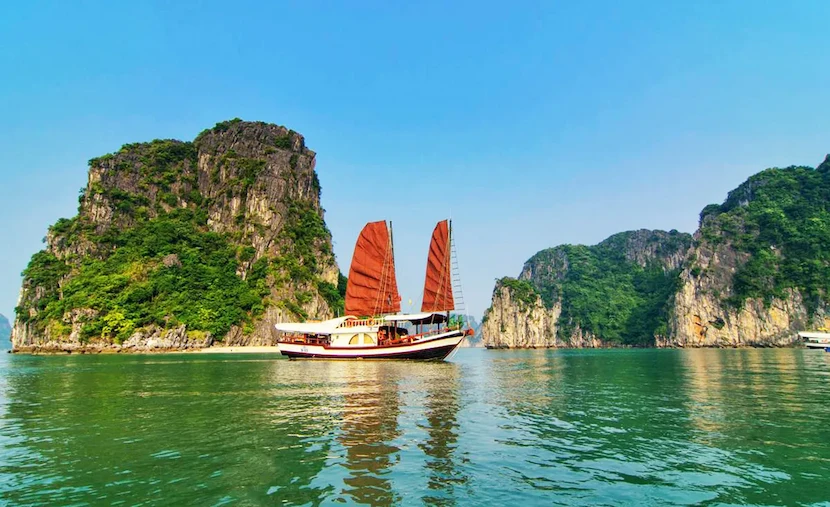
While Halong Bay is undoubtedly stunning, it can also become more pupular. If you're looking for a more peaceful and intimate experience, I highly recommend exploring Bai Tu Long Bay. The spectacular landscape of karst islands, but with fewer tourists and a more tranquil atmosphere will reassure an unforgettable experience. This makes Bai Tu Long Bay a great place for nature lovers and those who want to escape the hustle and bustle of larger tourist destinations.
3. Inspiring Northeast Vietnam Itineraries
3.1. Ha Giang Loop Itinerary (3 Days)
Brief program:
Day 2: Ha Giang - Dong Van
Day 3: Dong Van - Ha Giang - Hanoi
The Ha Giang Loop is widely known by backpackers as one of the world's most scenic trekking routes. This 3-day itinerary offers an unforgettable journey through the rugged and picturesque landscapes of Northeast Vietnam. Explore remote villages, conquer winding mountain roads, and immerse yourself in the rich culture of the Hmong and Dao ethnic groups. Backpackers can take a sleeper bus from Hanoi to Ha Giang City (approximately 300 kilometers), then rent a motorbike to embark on their adventure.
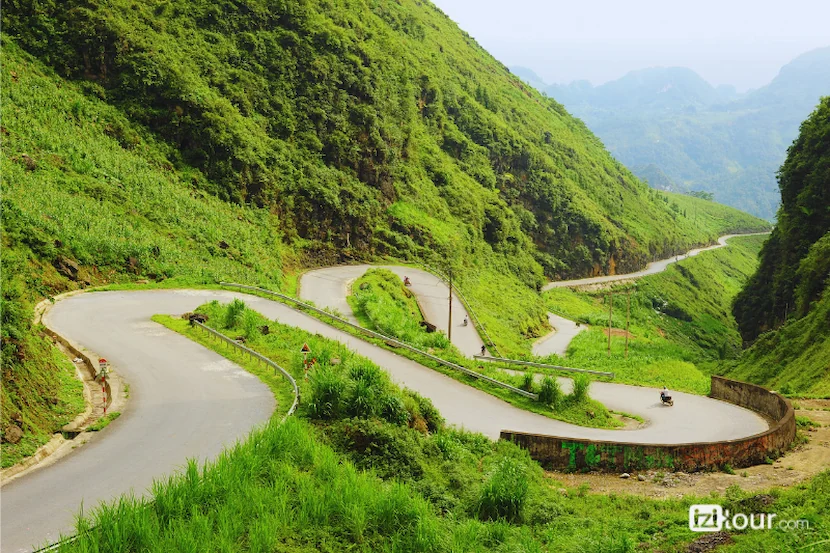
3.2. Hoang Su Phi Hiking Tour to Visit Rice Terraces & Ethnic Minorities (4 Days)
Brief program:
Day 2: Hoang Su Phi
Day 3: Hoang Su Phi
Day 4: Hoang Su Phi - Hanoi
This 4-day hiking adventure will bring you through the breathtaking rice terraces of Hoang Su Phi. This fully-guided tour combines the comfort of Panhou Retreat with the cozy feel of a local homestay, providing a perfect blend of comfort and exotic experiences.
Each day, you'll hike 15-18 kilometers, exploring the stunning mountain landscapes and lush tea plantations. As you trek, you'll have the opportunity to immerse yourself in the rich culture of the various Vietnamese ethnic groups. This tour is an ideal choice if you're seeking breathtaking scenery, off-the-beaten-path adventures, and a deep connection with local communities.
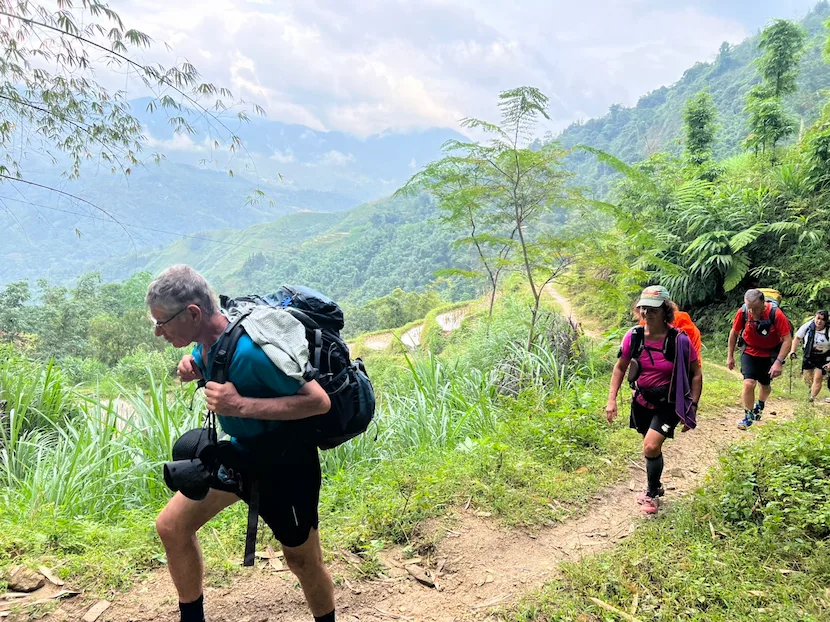
3.3. Itinerary to Northeast Vietnam's Highlights (5 Days)
Brief program:
Day 2: Ha Giang - Dong Van
Day 3: Dong Van - Bao Lac
Day 4: Bao Lac - Ba Be
Day 5: Ba Be - Hanoi - Departure
This 5-day itinerary to Ha Giang, Dong Van and Ba Be offers a comprehensive overview of Northeast Vietnam's highlights. You'll conquer the Ma Pi Leng Pass and explore villages of the Hmong and Dao ethnic groups. Immerse yourself in the natural beauty of Ba Be National Park, Vietnam's largest freshwater lake, and experience the serenity of a boat tour amidst stunning scenery. Immersing yourself in the region's natural beauty and cultural richness will be a great holiday.
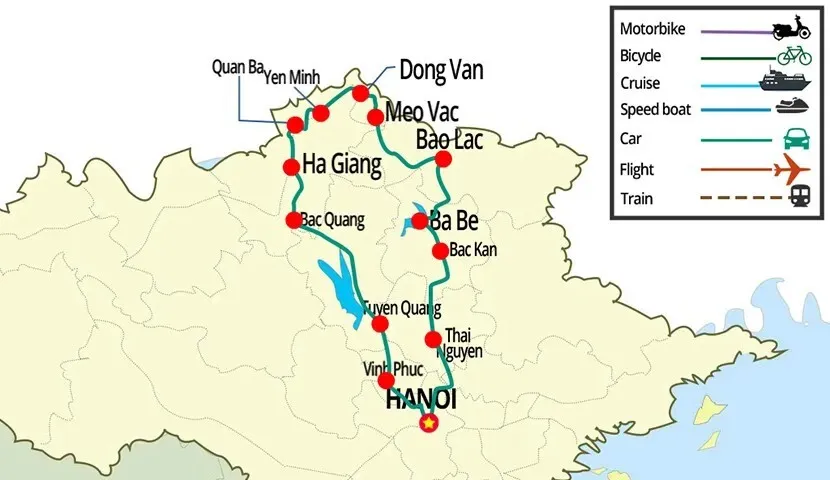
3.4. Bac Son - Cao Bang - Ba Be Discovery ( 6 Days)
Brief program:
Day 2: Bac Son - Cao Bang
Day 3: Cao Bang
Day 4: Cao Bang - Ba Be
Day 5: Ba Be
Day 6: Ba Be - Hanoi
If you have 6 days for Northeast Vietnam, refer to this 6-day adventure that combines the majestic Ban Gioc Waterfall, the largest natural lake in Vietnam - Ba Be Lake, and the charm of Bac Son Valley. You will explore the cascading beauty of Ban Gioc, a natural wonder bordering China, cruise the emerald waters of Ba Be Lake, surrounded by limestone karsts and lush rainforests, and delve into the rich natural heritage of Bac Son Valley. This itinerary invites you to visit the breathtaking scenery, encounter local ethnic groups, and have unforgettable experiences.
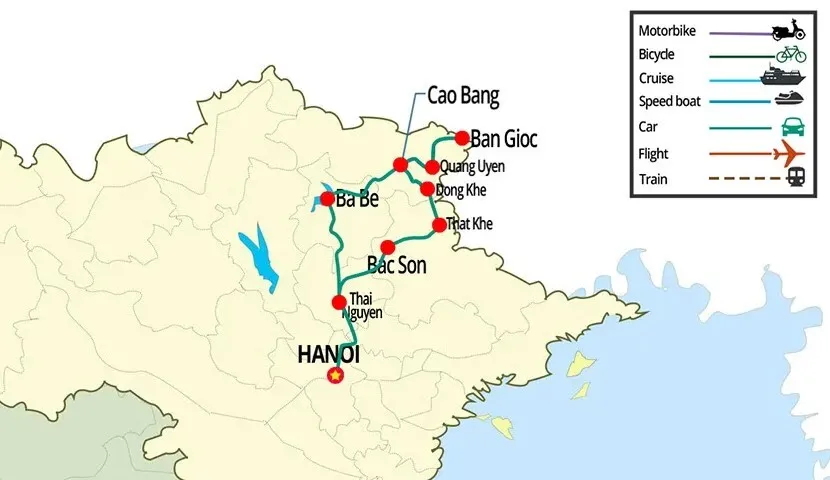
3.5. Itinerary to The Charming Beauty of the Northeast Vietnam (8 Days)
Brief program:
Day 2: Ha Giang - Dong Van
(optional 1 extra day in Ha Giang to hike through stunning landscapes and Dao ethnic villages)
Day 3: Dong Van - Bao Lac
(optional 1 extra day in Dong Van to visit Lung Cu Flagpole, Lo Lo Village and hike to Nho Que River)
Day 4: Bao Lac - Cao Bang
Day 5: Cao Bang
Day 6: Cao Bang - Ba Be
Day 7: Ba Be
Day 8: Ba Be - Hanoi - Departure
This tour will take you to explore the cultural and charming natural beauty of Northeast Vietnam, including Ha Giang, Dong Van, Cao Bang and Ba Be National Park. You may trek deeper into the villages, but you will be rewarded with beautiful views that few people get to see. You will also visit Vietnam’s most beautiful waterfall and natural caves. The rich traditions of Vietnam’s ethnic minority groups come to life as you interact directly with the locals.
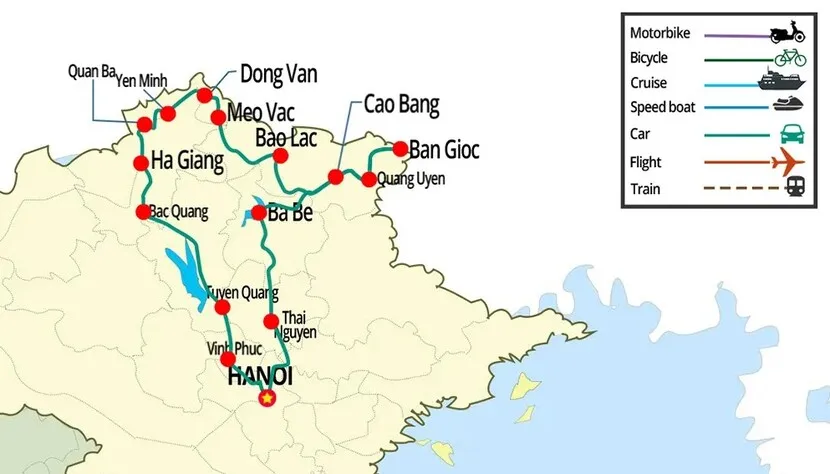
3.6. Bai Tu Long Bay and Northeast Vietnam Itinerary (9 Days)
Brief program:
Day 2: Hanoi Sightseeing
Day 3: Hanoi - Ha Giang
Day 4: Ha Giang - Dong Van
Day 5: Dong Van - Bao Lac
Day 6: Bao Lac - Ba Be
Day 7: Ba Be - Hanoi
Day 8: Hanoi - Bai Tu Long Bay
Day 9: Bai Tu Long Bay - Hanoi - Departure
Northeast Vietnam is truly a hidden gem waiting to be discovered. IZITOUR invites you on our 9-day 'Northeast Highlights' adventure! Our expert guides will accompany you on a journey through the majestic Ha Giang, where you'll explore the rich history of Dong Van, then Cao Bang, where you’ll marvel at the breathtaking Ban Gioc Waterfall. A serene cruise on Ba Be Lake will captivate your senses. Join us to immerse yourself in the unique culture of the Hmong people and explore Bai Tu Long Bay. With hiking adventures, cultural experiences and delicious local cuisine, this tour promises a journey full of wonderful moments.

4. Best time to visit Northeast Vietnam
You can make your adventure to this region at any time, as Northeast Vietnam offers year-round beauty, with each season showcasing its unique charms.
In January and February, visitors can witness the stunning spectacle of peach and plum blossoms adorning the mountainsides. March and April bring the vibrant red bombax ceiba flowers to the mountain roads, while the terraced fields are bustling with farming activity during the planting season of June and August. September and October offer the golden hues of ripe rice. However, it's the months of October and November that truly captivate with the delicate transformation of buckwheat flowers from white to purple and light pink. Finally, December brings the cheerful yellow mustard flowers to bloom.
Northeast Vietnam is a region renowned for its breathtaking landscapes, rich cultural heritage, and unique ethnic diversity. This mountainous region, with its rugged terrain, terraced rice fields, and traditional villages, offers a stark contrast to the bustling cities of the south. By visiting this region, you can contribute to sustainable tourism, supporting the local community's economic development and improving livelihoods. Your presence helps preserve indigenous cultures and promotes harmonious coexistence with nature.
If you would like to experience Northeast Vietnam on your next adventure, contact us via email [email protected] or Whatsapp +84 382 536 266. Share your thoughts with me and we can plan your North East Vietnam holiday together from now.
See More Northeast Vietnam Tours
See more:
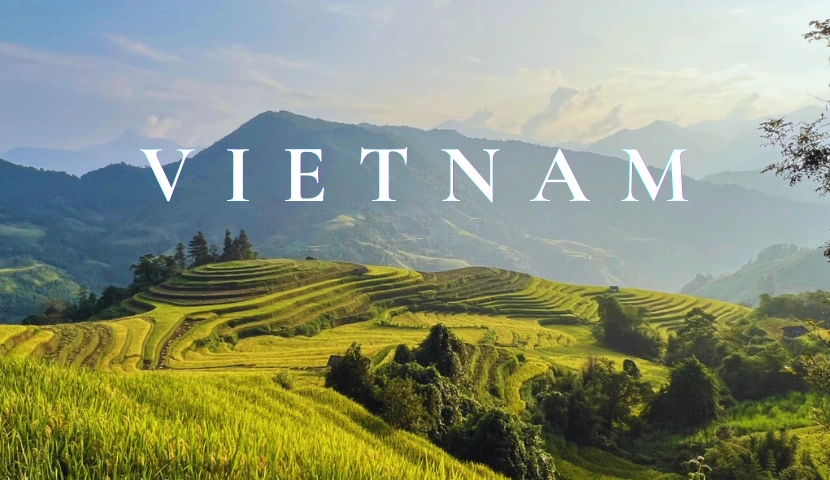







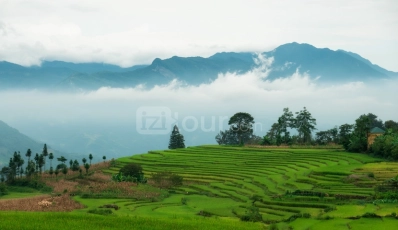
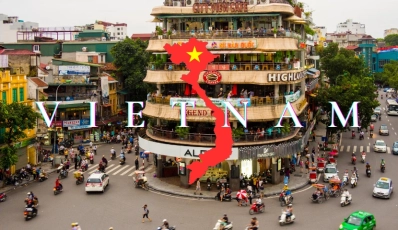
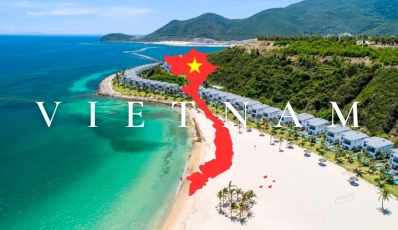
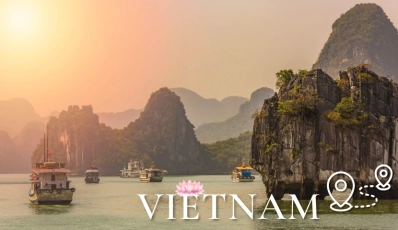
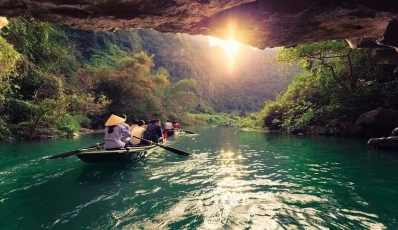
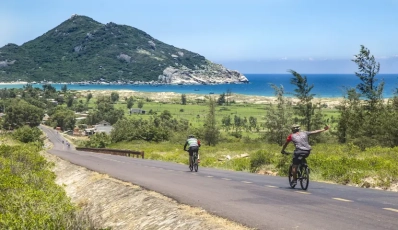
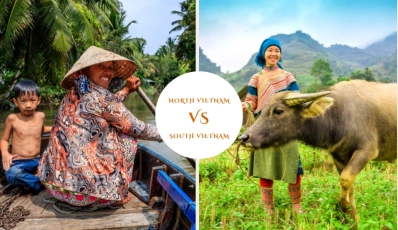
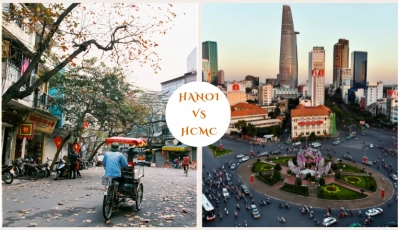
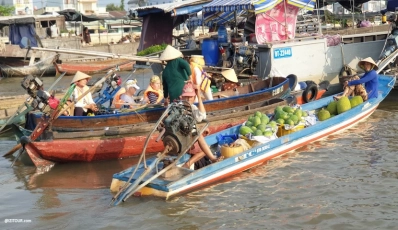




 TRAVELERS' CHOICE 2025
TRAVELERS' CHOICE 2025 



04 Comments
United States
Vietnam
France
Vietnam
Write Reply